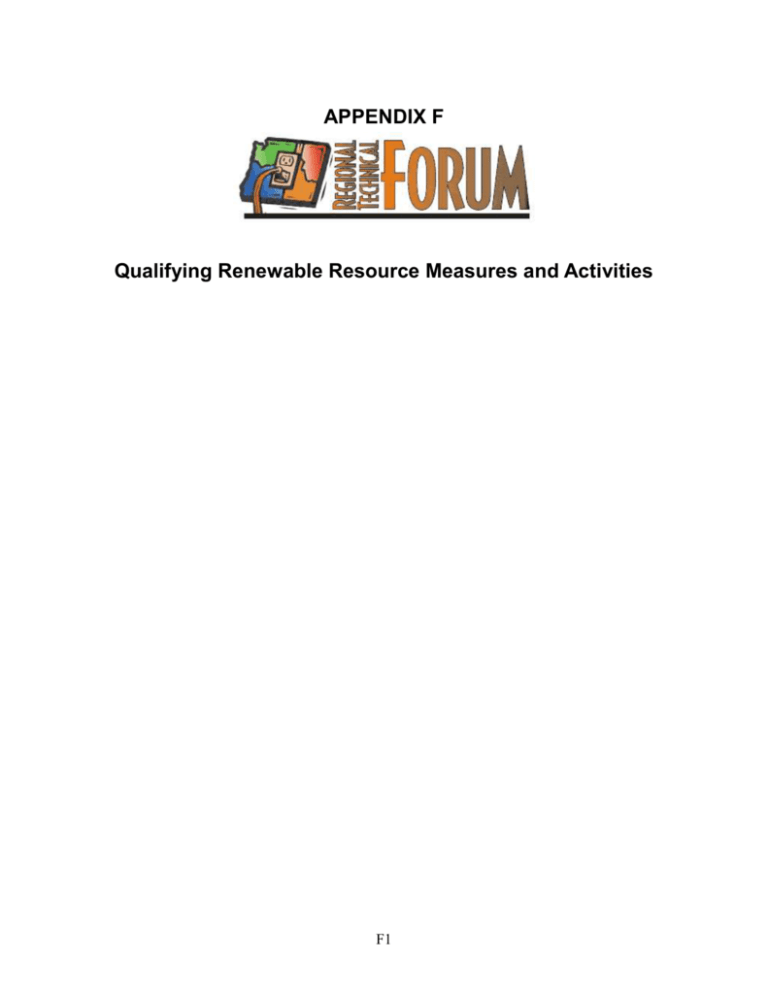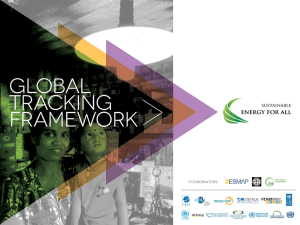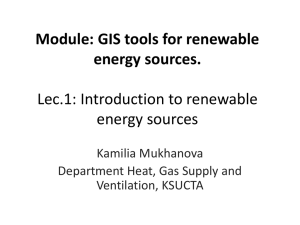APPENDIX F - Northwest Power & Conservation Council
advertisement

APPENDIX F Qualifying Renewable Resource Measures and Activities F1 TABLE OF CONTENTS METERED RENEWABLE RESOURCES GENERATING ELECTRIC POWER .............................. 3 BIOMASS ...................................................................................................................................................... 3 GEOTHERMAL ............................................................................................................................................ 5 HYDROPOWERr .......................................................................................................................................... 5 SOLAR ........................................................................................................................................................... 5 WIND ............................................................................................................................................................. 6 ADDITIONS AND UPGRADES AT EXISTING RENEWABLE RESOURCE GENERATING FACILITIES................................................................................................................................................... 6 HYBRID FACILITIES .................................................................................................................................. 7 UNMETERED RENEWABLE GENERATING RESOURCES ON THE CUSTOMER'S SIDE OF THE METER AND DIRECT APPLICATION RENEWABLE RESOURCES ..................................................... 7 F2 METERED RENEWABLE RESOURCES GENERATING RESOURCES ELECTRIC POWER The RTF recommends that the production or purchase of electricity from separately metered generating facilities using qualified renewable resources qualify for the C&R Discount. These include the following resources: (add basis of payment) Biomass This diverse category includes generating facilities using heat derived from combustion of plant matter, or from combustion of gases or liquids derived from animal waste or sewage, or from combustion of gases (but not toxic liquids) derived from plant matter, or from combustion of gases derived from landfills, or which derive hydrogen from these same sources to generate electricity using fuel cells. Energy production from a variety of biomass-fired power plants should qualify for the C & R Discount. Qualifying facilities may use various combinations of the feedstocks, fuel conversion technologies and generating technologies described below: Qualifying feedstocks include: Mill residues - the residues of lumber and wood products manufacturing activities including sawdust, shavings, bark and trimmings. Agricultural field residues - in the Northwest, primarily the stalk and chaff residues of grain and seed production. Also includes combustible residues of a wide variety of fruit, vegetable and nut production activities. Animal manure - manure and bedding byproducts of livestock and poultry operations. Forest residues - combustible residues of forest operations including logging, removal of stagnant or dying timber, hardwood stand conversion, pruning and thinning. Clean municipal solid waste biomass fractions such as yard debris, pallets and wooden construction debris. Landfill gas - combustible gas derived from the anaerobic decomposition of organic matter in landfills. Wastewater treatment plant gas - combustible gas derived from the treatment of municipal wastewater. Dedicated energy crops - energy crops grown on agricultural land with the whole plant harvested for its energy content. Hybrid black cottonwood is a potential energy crop in the Pacific Northwest. Qualifying fuel conversion technologies - Most biomass receives some degree of processing prior to use as fuel. Processing may range from basic physical operations such as sorting or chipping to complex chemical or thermal transformations into higher value solid, liquid or gaseous fuels. A wide variety of processes may be used to convert raw biomass into a variety of higher-value solid, liquid or gaseous fuels. Advanced generating technologies, such as combustion turbines or fuel cells require that the raw biomass be converted into a higher-quality fuel. Some fuel conversion processes yield recoverable thermal energy as a byproduct. Some of the fuel conversion processes that may be used in qualifying facilities include: F3 Separation - physical separation of materials into components having different characteristics. Particle size reduction - reduction in fuel particle size to facilitate transportation, storage, conversion or combustion. Drying - removal of moisture contained within the feedstock. Fabrication - fabrication of solid fuels from a variety of feedstocks. Anaerobic digestion - production of methane and carbon dioxide from biomass and water by anaerobic organisms. Occurs in-situ in landfills. Used in the controlled processing of municipal wastewater and for recovery of energy from animal manure. Alcoholic fermentation - production of ethanol from biomass and water by yeasts under anaerobic conditions. Pyrolysis - production of a low-Btu combustible gas by controlled thermal decomposition of organic materials in the absence of oxygen. Subsequent processing can yield higher quality synthetic gaseous, liquid or solid fuels.. Partial oxidation gasification - Production of low-Btu combustible gas by controlled partial combustion of organic materials. Subsequent processing can yield higher quality synthetic gaseous, liquid or solid fuels. Steam reforming - conversion of water (as steam) and carbonaceous materials (e.g. methane) to carbon monoxide and hydrogen. Hydrogenation - addition of hydrogen to carbonaceous materials to produce materials with a high hydrogen-to-carbon ratio such as liquid fuel. Qualifying generating technologies - A variety of technologies can be used to generate electric power from biomass fuels or their derivatives. Conventional steam-electric power plants are the predominate technology for generating power using solid biomass fuels. Reciprocating enginegenerator sets are the predominant technology for generating power from gaseous biomass fuels. Efforts are being made to introduce technologies with higher thermal efficiencies, such as combustion turbines; technologies with lower environmental impacts such as fuel cells; and technologies suitable for small-scale applications such as micro (combustion) turbines. The advanced technologies often require upgraded fuels. Qualifying generating technologies include: Reciprocating engine-generator sets Simple-cycle gas (combustion) turbines (various cycle configurations). Fuel cells (various technologies) Steam-electric plants (including atmospheric pressure fluid bed furnaces) Combinations of these (e.g. combined-cycle combustion gas turbines). Cogeneration - Qualifying biomass facilities may support cogeneration loads. The electric energy production of either cogeneration or non-cogeneration facilities qualifies for the credit as renewable electric power. The thermal energy production of a qualifying cogeneration facility qualifies for the credit as a direct application renewable if it displaces electrical loads. Examples of qualifying biomass facilities typical of the Northwest include: Steam-electric cogeneration power plant using mill residues. Reciprocating engine-generator power plant using landfill gas. Reciprocating engine-generator power plant using fuel gas derived from animal manure. Reciprocating engine-generator power plant using fuel gas recovered from wastewater treatment facilities. F4 Geothermal This category includes metered facilities using naturally-occurring underground (geothermal) heat to generate electric power. Power from a geothermal generating plant using any of the resources or technologies described below should qualify for the C&R Discount: 1. Vapor-dominated reservoirs producing dry steam that used directly in steam turbine generators. 2. High- and medium- temperature hydrothermal reservoirs producing superheated liquid used to flashed to steam to power a steam turbine-generator. 3. Binary-cycle geothermal technology using a low boiling point working fluid used to generate electric power from some low-temperature hydrothermal geothermal fluids. Bonneville proposes to credit new geothermal projects at a higher rate than additions to existing projects to promote exploration of new geothermal resources and applications. If requested by Bonneville, the RTF will determine whether a project is new or an addition on a case-by-case basis. Because it is possible that the distinction between new and existing projects will be an issue for the C&R Discount, the RTF will develop criteria for assessing specific proposals. Hydropower Qualifying facilities in this category include hydropower facilities located outside of protected areas as defined by the Northwest Power Planning Council, federal or state agencies or established by applicable statutes. Solar Qualifying facilities in this category include metered facilities producing electricity from solar irradiation. A wide variety of technologies and applications are possible. Qualifying technologies include the following: Crystalline silicon photovoltaic devices. Thin-film photovoltaic devices, including products integrated with building components. Concentrating photovoltaic devices. Central-receiver (power tower) solar thermal technology. Point-focus parabolic dish solar thermal technology. Parabolic trough solar-thermal technology. Qualifying applications include those described below, if separately metered. Rack-mounted photovoltaic arrays - Small-scale photovoltaic systems using arrays of standard photovoltaic modules affixed to roofs or separate supporting structures. May use fixed racks or tracking mounts to improve efficiency. Central-station power plants - Large-scale power plants sited for optimum solar resource. May use any of the technologies listed above. Building-integrated photovoltaic devices - Small-scale photovoltaic systems using photovoltaic surfaces that are integrated with roofing, glazing and cladding products. F5 Improved aesthetics and functional economies at some sacrifice in efficiency. Bonneville proposes to credit new solar projects at a higher rate than additions to existing projects to promote exploration of new solar resources and applications. If requested by Bonneville, the RTF will determine whether a project is new or an addition on a case-by-case basis Wind Qualifying facilities in this category include metered facilities that generate electric power from wind. The category includes power from both central-station wind power plants and separatelymetered single or clustered wind turbine generators. All wind turbine-generator technologies qualify. Bonneville proposes to credit new projects at a higher rate than additions to existing projects to promote exploration of new wind resource areas. If requested by Bonneville, the RTF will determine whether a project is new or an addition on a case-by-case basis. Additions and Upgrades at Existing Renewable Resource Generating Facilities An addition is the incremental expansion of generating capability obtained by installation of additional power generating equipment at an existing site. An example might be the installation of an additional wind turbine at an existing wind power project. An upgrade is an incremental expansion of generating capability obtained through improvement to the energy conversion efficiency of an existing facility. Upgrades are generally secured by replacing or rebuilding component equipment. Under provisions of the Regional Power Act, upgrades are of two types. Upgrades that result in a reduction of electric power consumption are considered to be conservation. An example would be replacement of main power transformers with higher efficiency units. Upgrades that result in increased gross power generation are considered to be generating resources. An example might be generator rewinding. The RTF recommends that an incremental increase in net power production resulting from additions to the generating capability of an existing and otherwise qualifying renewable project should qualify for the C&R Discount as new production. An incremental increase in the net power production of an otherwise qualifying existing renewable project that results from an increase in gross power generation should also qualify for the C&R Discount as new production. Examples of potentially qualifying measures resulting in increased gross power production include the following: Hydro turbine runners of improved design and materials, air injection, contour reshaping and seal improvements. Steam or gas turbine design and materials improvements, including blade replacement and seal improvements. Electronically-controlled hydro turbine governors incorporating automatic index testing. Improved generator cooling systems that reduce air frictional losses. Generator rewinding to reduce resistance losses and to increase machine capacity. Improved hydropower water use - Reduction in bypass water losses by measures such as improved spillway gate seals, improved gate position indicators and bypass water energy recovery facilities (e.g. turbine-generators using fish attraction water) F6 The RTF further recommends that an incremental increase in the net power production of an otherwise qualifying existing renewable project that results from a reduction in electric power consumption should qualify for the C&R Discount as conservation. The RTF recommends that qualification of production resulting from upgrades should be limited to incremental increases exceeding existing project design specifications. It is possible that a new qualifying project may be upgraded during the period that the C&R Discount is in effect. In these cases the RTF recommends that the resulting creditable production of the facility be the net production of the facility less the increment attributable to the conservation upgrade. Examples of upgrades qualifying as conservation measures include the following High-efficiency main power transformers. Reduction in station-service loads by measures such as efficient pumps and motors, high-efficiency lighting and controls, load balancing, power factor correction, highefficiency station service transformers, removal of unnecessary voltage regulators, heating, ventilation and air conditioning improvements and weatherization. Hybrid facilities Some generating facilities may use both qualifying and non-qualifying energy sources. The RTF recommends that the qualifying fraction be computed as the portion of the total net electricity production attributable to the qualifying energy resource, considering the estimated conversion efficiencies for qualifying and non-qualifying energy sources. Examples of hybrid facilities include the following: A parabolic trough solar-thermal power plant using steam-electric generating technology with a natural gas-fired boiler for producing supplementary steam during periods of non-peak solar irradiation. A distributed wind turbine with an ancillary diesel generator set for supplementary power production during periods of non-peak wind. A low-Btu biogasification generating plant with supplemental natural gas firing for combustion stability. A natural gas combined-cycle power plants co-fired with gas derived from biomass sources. UNMETERED RENEWABLE GENERATING RESOURCES ON THE CUSTOMER’S SIDE OF THE METER AND DIRECT APPLICATION RENEWABLE RESOURCES The RTF recommends that unmetered renewable resources located on the end use customer’s side of the meter that generate electricity and direct application renewable resources1 be treated as conservation for the purposes of determining their C&R Discount. However, in computing their value to the region’s bulk power system the Act’s 10 percent credit for conservation should not be applied to these resources. The RTF recommends that use of biomass (e.g., wood or wood products) for space heating not be considered a direct application renewable resource for purposes of the C & R Discount. 1 Direct application renewable resources utilize solar, wind, hydro, geothermal, biomass, or similar sources of energy to perform end use functions without being converted to electricity. F7 ________________________________________ p:\ss\web-page\rtf\finalrecommendations\appendixf.doc F8








